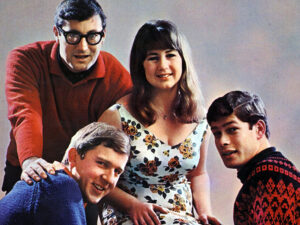I read with sadness this week of the death of Judith Durham, lead singer of The Seekers pop/folk group from Australia. They were sensational and defined a whole era with songs like Morningtown Ride, Georgie Girl and—my favorite—I’ll Never Find Another You.
 The Seekers in their heyday
The Seekers in their heyday
The reason I bring this up is that she died of lung cancer, even though she had never smoked (not quit—never smoked). The supposition is that she was exposed to secondhand smoke while playing the bars and clubs earlier in her career. It turns out to be a real risk factor for performers.
I remember well the misfortune of UK artist Roy Castle (1932 – 1994) who ended up the same way. He was a comedian and trumpeter and he too had played in lots of clubs and bars. And he too had never smoked but was felled by lung cancer. He was one of the first people I know to highlight the real risk we all face from smokers: their smoke effluvium is deadly, possibly more so than the nicotine and tar that we all worry about.
Vivien chipped in with a reminder that Christopher Reeve’s wife, Dana, had also died of lung cancer at the horribly young age of just 44. Her status too was never-smoked. Notwithstanding, she perished just 17 months after her husband Christopher.
Why? Why do these good people and millions like them—who live well, eat properly and do all the right thing—still die of lung cancer? It all seems so unfair.
And how much at risk are we all?
Fact is, lung cancer is the deadliest cancer of the lot, causing the most cancer-related deaths worldwide. Every year, more than 2 million people around the world are diagnosed with the disease. Unfortunately, lung cancer in people who have never smoked is one of the most lethal versions of this cancer.
Obviously, most people who develop lung cancer have a history of tobacco smoking, but 10% to 20% of people who develop lung cancer have never smoked. Lung cancer in never smokers occurs more frequently in women and at an earlier age than lung cancer in smokers.
What causes this? As I have hinted, secondhand cigarette smoke is probably the #2 risk factor for contracting the disease. Smokers, if they cannot control their cravings, have no right whatsoever to subject those around them to this considerable danger.
Be rude! Tell them to pi** off!
Each year, about 7,000 adults in the USA, for example, die of lung cancer as a result of breathing secondhand smoke. Laws that ban smoking in public places have helped to reduce this danger.
Other Risk Factors
While it’s true that staying away from tobacco is the most important thing any of us can do to help lower our risk of getting lung cancer, there are also other risk factors. Some of the risk factors for lung cancer can cause changes or mutations in the lung cells. These changes can lead to abnormal cell growth and sometimes cancer.
A percentage of those people who get lung cancer have no known risk factors.
Obviously tobacco, for all its fearsome reputation, is not the sole cause of pathological changes in the lungs! Other chemical toxins, including traffic fumes, air pollution and asbestos are well recognized. Pre-existing lung diseases are also a factor. But the fact is that scientists still don’t know what causes the majority of these cancers in non-smokers.
Exposures at work may play a part. Some people are exposed to carcinogens such as arsenic, uranium, asbestos and diesel exhaust at their workplace. Work-related exposure to such cancer-causing materials has decreased as governments and industry have taken steps to help protect workers. Still, if you work around these agents, be careful to limit your exposure whenever possible.
Worship fresh air
Radon Gas
Radon222 is a naturally occurring radioactive gas that results from the breakdown of uranium in soil and rocks. Outdoors, there is so little radon that it is not likely to be dangerous. But if there is radon indoors, it can become more concentrated and is a serious health hazard, when present.
According to the US Environmental Protection Agency (EPA), radon is the second leading cause of lung cancer in the USA, and may be responsible for as many as 10,000 to 30,000 lung cancer deaths each year, which makes it definitely the leading cause among people who don’t smoke. The World Health Organization estimates radon plays a role in 6% to 15% of all lung cancer deaths worldwide.
High indoor levels of radon gas are now more prevalent than historically, probably because of our energy-efficient, double-glazed and insulated buildings that trap air and keep it from circulating freely.
Granite rock areas are worst affected. In the US, high-risk localities are Maine, Pennsylvania, New Jersey and Florida. In Britain, danger zones are Cornwall and the Aberdeen area (Grampian). In France, Brittany and Normandy are bad. Sweden seems particularly hard hit and the government there has taken the matter very seriously.
The real concern is not radon gas itself, which is technically inert, but so-called ‘radon daughters’. These are decay products—radioactive solids that can than attach themselves to airborne microscopic particles such as dust or cigarette smoke and lodge in the lungs. Here they will irradiate tissues and are known to add to the likelihood of lung cancer. Exposure to radon daughters by inhalation represents about half of the total dose of radiation humans get from all natural “background” sources.
Safety Limits
The allowed levels and different measurement units have changed over the decades, since I first began writing about this (1992). At first it was milli-Sieverts, then Bequerels per sq. metre. Now we talk of picoCuries per litre (pCi/L).
Generally speaking, levels of less than 4.00 pCi/L should be aimed for.
The 2009 WHO Handbook On Indoor Radon – A Public Health Perspective recommends setting a level of 2.7 pCi/L, if possible, or as-low-as-reasonably-achievable (ALARA), but should definitely not exceed 8.1 pCi/L.
That will save a LOT of lives. Remember, there is no known safe level (indeed, no safe level at all) but 2.7 pCi/L is a good working target. You can download the WHO radon handbook here.
Testing Your Home For Radon
Best to know EXACTLY what you are facing, whether a supposedly safe region, or a known danger zone, such as those listed above.
- You can buy a radon test kit from a home improvement store.
- Or hire a radon measurement certified specialist (consult your local certification body and be sure you are getting a good investigator).
 The Pro-lab RA100 Gas Test Kit
The Pro-lab RA100 Gas Test Kit
Viv and I have a home in France (as well as Las Vegas) and that, unfortunately is in a zone 3 (maximum danger). Luckily, we are well ventilated and—most importantly—do not spend all our time there!
I hope this helps if you are a non-smoker and, of course, it could save your life to reduce your radon exposure if you ARE a smoker (Tut, tut!)
Just can’t hold your breath I’m afraid!
To your good health,
Prof. Keith Scott-Mumby
The Official Alternative Doctor




